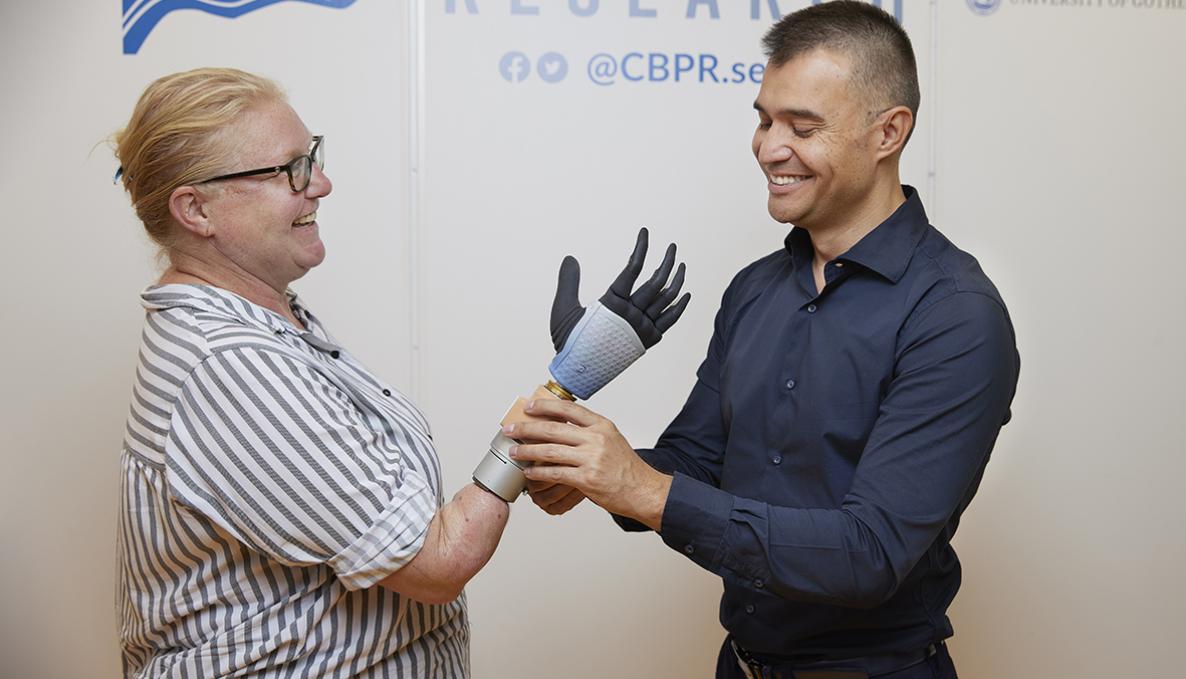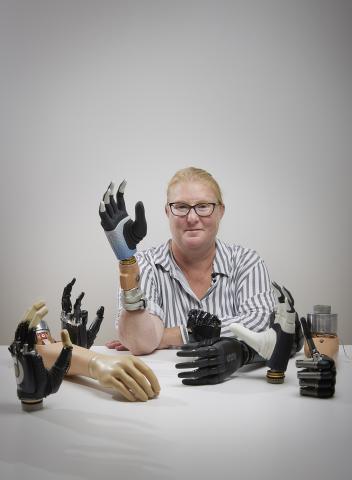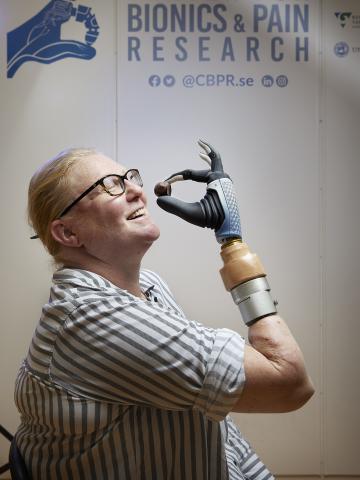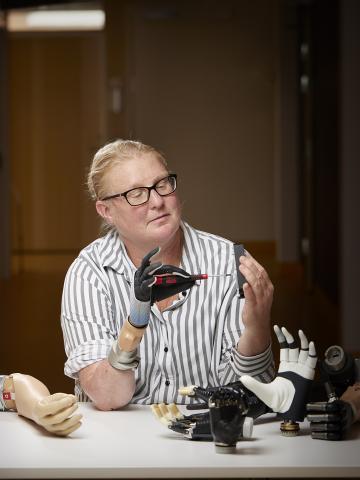Groundbreaking Achievement as Bionic Hand Merges with User’s Nervous and Skeletal Systems, Remaining Functional After Years of Daily Use

Revolutionizing Prosthetics: The long-term integration of a bionic hand into the user’s nervous and skeletal systems has been reported as successful for the first time. A Swedish woman who lost her right hand in a farming accident was implanted with a novel human-machine interface into her residual bone, nerves, and muscles. The residual limb was surgically modified to better integrate with the bionic hand that uses A.I. to understand her commands. The study was published in the journal Science Robotics and involved researchers in Sweden, Italy, and Australia.
Karin's life took a dramatic turn when a farming accident claimed her right arm over 20 years ago. Since then, she endured excruciating phantom limb pain. “It felt like I constantly had my hand in a meat grinder, which created a high level of stress and I had to take high doses of various painkillers.” In addition to her intractable pain, she found that conventional prostheses were uncomfortable and unreliable, and thus of little help in daily life. All this changed when she received groundbreaking bionic technology that allowed her to wear a much more functional prosthesis comfortably all day. The higher integration of between the bionic and Karin’s residual limb, also relieved her pain. “For me, this research has meant a lot, as it has given me a better life”.
A Remarkable Fusion of Human and Machine
Mechanical attachment and reliable control of prosthetic limbs are two of the biggest challenges in artificial limb replacement. People with limb loss often reject even the sophisticated prostheses commercially available because of these reasons, meaning painful and uncomfortable attachment with limited and unreliable controllability. A multidisciplinary group of engineers and surgeons solved these problems by developing a human-machine interface that allows for the prosthesis to be comfortably attached to the user’s skeleton via osseointegration, while also enabling electrical connection with the nervous system via electrodes implanted in nerves and muscles (video at https://youtu.be/YRxtM0Y6ZAQ).
The research was led by Prof. Max Ortiz Catalan, head of neural prosthetics research at the Bionics Institute in Australia and founder of the Center for Bionics and Pain Research (CBPR) in Sweden. “Karin was the first person with below-elbow amputation who received this new concept of a highly integrated bionic hand that can be used independently and reliably in daily life. The fact that she has been able to use her prosthesis comfortably and effectively in daily activities for years is a promising testament to the potential life-changing capabilities of this novel technology for individuals facing limb loss”. The challenges at this level of amputation are the two bones (radius and ulna) that should be aligned and loaded equally, and that not much space is available for implanted and prosthetic components. The research team nevertheless managed to develop a suitable neuromusculoskeletal implant that allows for connecting the user’s biological control system (the nervous system) with the electronic control system of the prosthesis. “Our integrated surgical and engineering approach also explains the reduction in pain, as Karin is now using somewhat the same neural resources to control the prosthesis as she did for her missing biological hand”. Treatment and prevention of post-amputation pain is another major goal for Prof. Ortiz Catalan’s team. Regarding this matter, Karin said to now have “better control over my prosthesis, but above all, my pain has decreased. Today, I need much less medication”.
A key feature of the new bionic technology is the skeletal attachment of the prosthesis via osseointegration; the process by which bone tissue embraces titanium creating a strong mechanical connection. Prof. Rickard Brånemark, research affiliate at MIT, associate professor at Gothenburg University, and CEO of Integrum, led the surgery and has worked with osseointegration for limb prosthesis since they were first used in humans: “The biological integration of titanium implants into bone tissue creates opportunities to further advance amputee care. By combining osseointegration with reconstructive surgery, implanted electrodes, and AI, we can restore human function in an unprecedented way. The below elbow amputation level has particular challenges, and the level of functionality achieved marks an important milestone for the field of advanced extremity reconstructions as a whole”.
The nerves and muscles in the residual limb were re-arranged to provide more source of motor control information to the prosthesis. Dr. Paolo Sassu conducted this part of the surgery that took place at the Sahlgrenska University Hospital in Sweden, where he also led the first hand transplantation performed in Scandinavia: “Depending on the clinical conditions, we can offer the best solution for our patients which sometimes is biological with a hand transplantation, and sometimes is bionic with neuromusculoskeletal prosthesis. We are continuously improving in both”.
Dr. Sassu is presently with the Istituto Ortopedico Rizzoli in Italy, and the Center for Bionics and Pain Research in Sweden.
“The DeTOP project, funded by the European Commission”, says Coordinator Prof. Christian Cipriani, from Scuola Sant’Anna, Pisa, “offered a great opportunity of collaboration which made possible the consolidation of state-of-art prosthetic and robotic technologies available in our institutions, that may have a terrific impact on people’s life”.
The robotic hand developed by Prensilia, namely Mia Hand, featured unique motor and sensory components that allowed the user to carry out 80% of the activities of daily living. “The acceptance of the prosthesis is critical for its successful use” says Dr. Francesco Clemente, Managing Director of Prensilia. “Besides technical performance, Prensilia struggled to develop a hand that could be fully customizeable aesthetically. Mia Hand was born to be shown and not hidden. We wanted the users to be proud of what they are, rather than ashamed of what was lost”.
This work was one of the main outcomes of a project funded by the European Commission under Horizon 2020 called DeTOP (GA #687905) (video). The research was also financed by the Promobilia Foundation, the IngaBritt and Arne Lundbergs Foundation, and the Swedish Research Council (Vetenskapsrådet).
Researchers are with the Center for Bionics and Pain Research (CBPR), a multidisciplinary collaboration between Sahlgrenska University Hospital, the Sahlgrenska Academy at the University of Gothenburg, and Chalmers University of Technology, all in Gothenburg, Sweden; the Bionics Institute in Melbourne, Australia; the Istituto Ortopedico Rizzoli, Bologna, Italy; the Scuola Superiore Sant’Anna, Pisa, Italy; TeamOlmed in Sweden; the University of Colorado, Aurora, USA; the Massachusetts Institute of Technology, Cambridge, USA; and the medical device companies Integrum AB in Sweden and Prensilia in Italy. The DeTOP project also included Lund University, the Swiss Center for Electronics and Microtechnology, INAIL Prosthetic Center, and Universitá Campus Bio-Medico.






